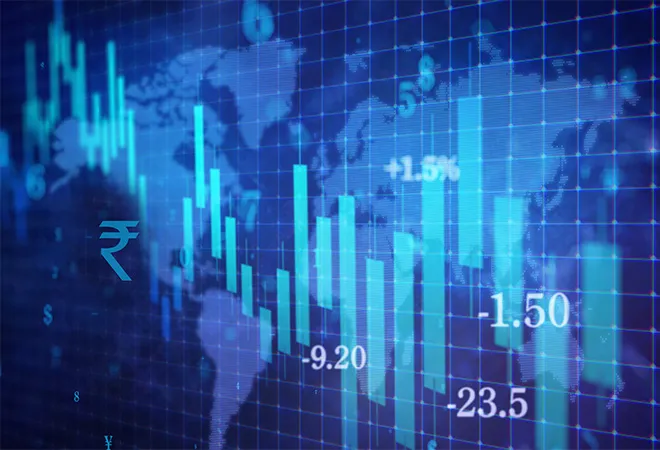-
CENTRES
Progammes & Centres
Location
Hard work on inflation means there is monetary space in this crisis; but years of mismanagement means there is no fiscal firepower

It should go without saying that 2020 is not 2008. The crisis through which the global economy is currently passing is not a financial crunch, but a public health crisis with an effect on the real economy. The sole similarity between the two moments from the point of view of the economy is the risk of a market freeze-up — caused in 2008 by a breakdown in finance, and in 2020 by temporary demand destruction — leading to long-term scarring, and the insolvency of otherwise going concerns. Then, as now, policymakers would respond to such a threat by flushing the system with liquidity of various kinds.
But this will play out in very different ways in 2021 than it did in 2009, because the underlying causes are different. In some sense, in 2008 the real economy was sound; it was finance that had overheated, causing five solid years of misallocation and imbalances across the world. In 2020, the real economy is what is under stress. Thus monetary measures in particular are the wrong tool to address the problem. This is in addition to the problems that we learned after 2008 that massive monetary easing could create — including asset price inflation, whiplash back and forth international financial flows, and growing inequality.
What is also different — and particularly relevant for India — is the macro-economic situation of governments, especially those in the emerging world. The developed world, at least for now, seems able to ignore macro-economic reality. It can triple its deficits and run up debt with minimal effect on financial stability and inflation at least in the short to medium term. But for emerging economies, the rules of the road still apply: Too much public debt as a proportion of GDP will lead to weakness, for example.
The differences between now and then, particularly for India, are threefold. First, the fiscal position; second, inflation; and third, China.
When it comes to the fiscal situation, the year 2008-09 is generally remembered as one of the disaster years for deficits and debt. The fiscal deficit more than doubled from 3.1 per cent of GDP to 6.5 per cent of GDP, driven not just by crisis spending but also by pre-election giveaways and the pay commission. It is almost amusing in hindsight to note that commentators then spent years calling that escalation some sort of catastrophic misjudgement — amusing because we are facing in this crisis an even sharper escalation in the deficit, to 9 per cent of GDP, according to CARE Ratings.
What is relevant is that this escalation is itself from a deficit target that was far wider than it should have been, given the favourable macro-economic factors facing the government for the past years. When the history of this period is written, the question that many will ask is why the deficit in the fiscal year 2019-20, with only one of its 52 weeks impacted by the pandemic lockdown, was almost 4.6 per cent of GDP, worse even than the much relaxed target of 3.8 per cent of GDP set as late as the February Union Budget. A fiscal deficit of that magnitude when there is no crisis to be dealt with is a millstone around your neck when one suddenly appears. It is this fiscal situation that has forced the government into caution when it comes to relief and stimulus spending.
While the fiscal situation may be worse than under the United Progressive Alliance in 2007-08, on inflation things are much better. In May-June 2008, shortly before the crisis hit, consumer price inflation was between 7 and 9 per cent, depending on which indicator you examined. Wholesale price inflation was 12 per cent in July 2008, which the Reserve Bank of India had blamed on high global commodity prices, weak agricultural production and strong demand. Consumer price inflation today is also around 7 per cent. But the RBI clearly thinks this is temporary. Certainly, it comes off a stable, lower base, and it is very likely that inflation expectations have been permanently anchored far lower than they were in 2008.
Across the emerging world, more benign inflation than in 2008 has allowed developing-world central banks to conduct more aggressive counter-cyclical monetary policy, including deploying unconventional instruments of the sort hitherto only used by rich-country central banks. In India, the RBI can quietly support the market for G-Secs as well as for high-grade corporate debt partly thanks to its confidence in being able to manage inflation going forward.
The final difference between today and 2008 is the position of the People’s Republic of China. It has launched no giant stimulus of the sort that supported the global economy in the years after the financial crisis. From India’s point of view, this is a mixed blessing. Global demand remains weak. But, crucially, there is no commodity price spiral either, of the sort caused by China’s giant post-2008 state-driven expansion of demand. This is in spite of the fact that China remains relatively insulated from the economic effects of the pandemic, and that — unlike after 2008 — India’s is one of the most damaged economies. Many analyses suggest that India’s contraction is itself enough to shave a percentage point off global growth, as opposed to the 0.5 percentage point it added to global growth in the year after the financial crisis. The difference also is that, in 2020, passive investors can flock to China, given its inclusion in international indices. Thus capital flows to China have been strong; to the emerging world ex-China, not so much. By contrast, in the year after the financial crisis, portfolio flows to emerging markets actually increased by 5 per cent.
When a crisis hits, it is time to consider what has been done well and what should have been done differently in the lead-up to the emergency. In this case, in spite of India’s claims to be a shining investment destination, it is clear that it has largely failed to even begin to match China as providing the necessary combination of depth, stability, and returns. More work should have been done in the good years to provide a cushion in bad ones.
This lesson is even starker when it comes to inflation and the deficit. The painful transition to inflation targeting — and it has exacted pain, with many in government and even some economists constantly bewailing the RBI’s supposed hawkishness — provides the country with some monetary wiggle room in bad time. Meanwhile, the government’s complete mismanagement of the fiscal side of the economy during the good years has come back to haunt it. The numbers suggest the fiscal side was in a worse state when the current government had to deal with this crisis than when its predecessor faced its crisis. The lack of hard work on the fiscal front, the unwillingness to make hard decisions in the good years, means there is no firepower when things turn bad.
This commentary originally appeared in the Business Standard.
The views expressed above belong to the author(s). ORF research and analyses now available on Telegram! Click here to access our curated content — blogs, longforms and interviews.

Mihir Swarup Sharma is the Director Centre for Economy and Growth Programme at the Observer Research Foundation. He was trained as an economist and political scientist ...
Read More +